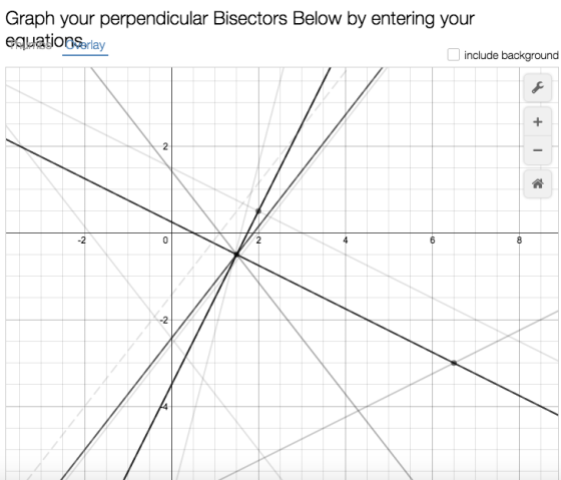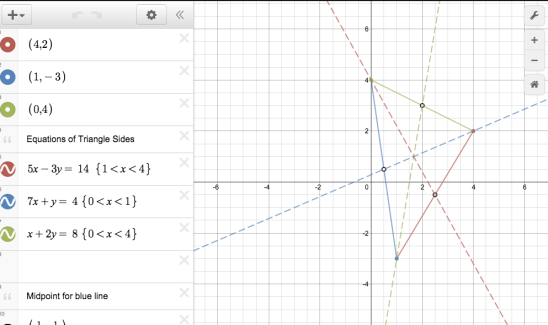Let me just start off by saying I LOVE Desmos Activity Builder. I’ve used already made ones for my algebra 1 class, but I decided to make my own for this unit in geometry. We just finished up our proving triangle congruence unit and started talking about points of concurrency. My students were introduced to the points of concurrency in our construction unit, but now we were learning how to find them algebraically. Also if you click on the links it will take you directly to my activities for Desmos and Peardeck!
Day 1 ( 90 minute )
I’ve thrown in algebra concepts all year through weekly problem sets using Delta Math. They did a lot of practice identifying slopes of lines and perpendicular lines by looking at an equation in standard form. So the first day was a refresher of identifying slope in standard form, and writing equations in standard form when given only the slope. We also practiced finding slope and then putting it into stardard form and solving for c.
I do a lot of partner white boarding in my class to do practice problems. In parter white boarding each table of two has 1 white board and one marker. Partners have to work together and talk about the problem to complete it. This also gives me a great chance to walk around and help students who are struggling. Students practiced finding equations of lines in standard form when given two points. I embedded a desmos link into my peardeck so students could check their answers with their partner. Students also practiced finding perpendicular lines.
The last problem of the class asked students to plot three coordinate points in their peardeck. My students were confused at first on why I was having them graph three points. Students quickly noticed that the three points create a triangle. With their partners students worked together to find the equations of the lines of the triangle and the perpendicular bisector of each side. I didn’t introduce that the point of intersection was the circumcenter quite yet.
When I do this next year I would give them more time to practice writing equations of lines in standard form and introduce perpendicular bisectors the next day. Here is a link to my PearDeck for Day 1.

Day 2 (55 min)
Day 2 started with my students checking their homework. I ususally have my homework answers in a google doc that I embed in my peardeck. This allows students to check their homework as soon as they walk in, and have the answers on their computer so they can check at their own pace.
On the next slide, I had a link embedded student.desmos.com, so they were directly taken to the next activity. I gave them the code to start their Desmos Activity. This is the first Desmos Activity that I created! It was awesome. I also had the activity (and my peardeck) pulled up on my ipad. This allows me see all of my students work while I walked around the classroom. I could also control my Peardeck through my Ipad, so I can control my slides and be anywhere in the room.
This Desmos Activity focused on finding perpendicular bisectors on every side of the triangle and discussed how they were finding the circumcenter of the triangle. At the end of the activity students were asked to check their equations again mine and then they imedietely were taken back to PearDeck. Then on Peardeck we received solving systems of equations to find where our circumcenter is located. I really wanted my students to nail down another form besides slope-intercept and solve systems other than substitution, so I had my students keep their equations in standard form and solve systems only using elimination. It was challenging at first, but my started are really starting to understand using standard form.
Day 3
Day three started the same way with students checking their homework on peardeck and answering homework questions. Day 3 was focused on finding the centroid. We worked on finding the midpoints and I had them check their midpoints compared to mine before moving on. Then I introduced creating medians from the midpoint to the opposite vertex. Student’s were able to practice with their partners and then were able to check their answers on the embedded Desmos.
Day 4
Day 4 was probably my favorite day. After checking homework and answering questions, I briefly introduced how to find the orthocenter via peardeck and then sent students to a desmos activity. This activity scaffoled the entire proccess. Students were able to go through each step and check their work against mine on each slide. Here is a link to my Desmos Activity!
I really like the activity builder for finding points of concurrency algebraically because students can check their work by graphing, can work at their own pace, and I can see their classwork during and after class! Although tricky, students are really grasping writing equations in standard form and finding the different points of concurrency. I loved this unit. It’s so fun to see how geometric shapes work algebraically !























